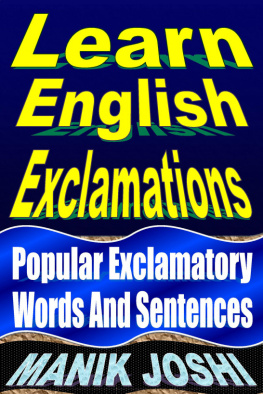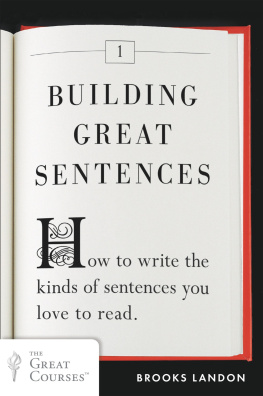PRACTICE MAKES PERFECT
Spanish Sentence Builder
PRACTICE MAKES PERFECT SpanishSentence Builder
Gilda Nissenberg


Copyright 2009 by The McGraw-Hill Companies, Inc. All rights reserved. Except as permitted under the United States Copyright Act of 1976, no part of this publication may be reproduced or distributed in any form or by any means, or stored in a database or retrieval system, without the prior written permission of the publisher.
ISBN: 978-0-07-160040-8
MHID: 0-07-160040-X
The material in this eBook also appears in the print version of this title: ISBN: 978-0-07-160039-2, MHID: 0-07-160039-6.
All trademarks are trademarks of their respective owners. Rather than put a trademark symbol after every occurrence of a trademarked name, we use names in an editorial fashion only, and to the benefit of the trademark owner, with no intention of infringement of the trademark. Where such designations appear in this book, they have been printed with initial caps.
McGraw-Hill eBooks are available at special quantity discounts to use as premiums and sales promotions, or for use in corporate training programs. To contact a representative please e-mail us at bulksales@mcgraw-hill.com.
TERMS OF USE
This is a copyrighted work and The McGraw-Hill Companies, Inc. (McGraw-Hill) and its licensors reserve all rights in and to the work. Use of this work is subject to these terms. Except as permitted under the Copyright Act of 1976 and the right to store and retrieve one copy of the work, you may not decompile, disassemble, reverse engineer, reproduce, modify, create derivative works based upon, transmit, distribute, disseminate, sell, publish or sublicense the work or any part of it without McGraw-Hills prior consent. You may use the work for your own noncommercial and personal use; any other use of the work is strictly prohibited. Your right to use the work may be terminated if you fail to comply with these terms.
THE WORK IS PROVIDED AS IS. McGRAW-HILL AND ITS LICENSORS MAKE NO GUARANTEES OR WARRANTIES AS TO THE ACCURACY, ADEQUACY OR COMPLETENESS OF OR RESULTS TO BE OBTAINED FROM USING THE WORK, INCLUDING ANY INFORMATION THAT CAN BE ACCESSED THROUGH THE WORK VIA HYPERLINK OR OTHERWISE, AND EXPRESSLY DISCLAIM ANY WARRANTY, EXPRESS OR IMPLIED, INCLUDING BUT NOT LIMITED TO IMPLIED WARRANTIES OF MERCHANTABILITY OR FITNESS FOR A PARTICULAR PURPOSE. McGraw-Hill and its licensors do not warrant or guarantee that the functions contained in the work will meet your requirements or that its operation will be uninterrupted or error free. Neither McGraw-Hill nor its licensors shall be liable to you or anyone else for any inaccuracy, error or omission, regardless of cause, in the work or for any damages resulting therefrom. McGraw-Hill has no responsibility for the content of any information accessed through the work. Under no circumstances shall McGraw-Hill and/or its licensors be liable for any indirect, incidental, special, punitive, consequential or similar damages that result from the use of or inability to use the work, even if any of them has been advised of the possibility of such damages. This limitation of liability shall apply to any claim or cause whatsoever whether such claim or cause arises in contract, tort or otherwise.
Contents
Introduction
A short paragraph that communicates an idea, a letter, or a written request to grab the attention of a reader are examples of what you want to be able write in Spanish. But in order to write each of these you have to learn how to build effective sentences to communicate your ideas clearly. Writing is a skill that presents challenges to those who want to communicate effectively in a foreign language.
This book will help you build your writing skills in Spanish. You will find the elements that you need: clear explanations of how different grammatical structures in the Spanish language must be combined to create sentences and abundant examples that illustrate how to combine the structures to build the sentences. You will start with the least complex sentences and move gradually to more complex structures.
The only way to acquire and improve writing skills is to practice writing. This book includes different types of exercises for you to practice as you learn. Some exercises ask for a variation of a model; others require that you use a series of words in the appropriate order to build a sentence, choose the most appropriate answer among multiple choices, or use the required punctuation to communicate the correct message.
You will find ample opportunities to write your own original sentences in a given context. As a result, your writing skills will improve. An answer key is provided at the end of the book with the correct answers and sample sentences for all but the most personalized exercises.
Sentence writing may be challenging at times. Paying close attention to instructions, practicing regularly, and applying the rules of sentence building consistently will make you a better writer. With this book you will discover ways to build your sentences and build your confidence as a writer in Spanish.
A escribir!
1 Declarative sentences and word order
Sentences and phrases are different in nature and serve different purposes to communicate ideas and thoughts.
What is a phrase?
A phrase consists of more than one word. It does not have the subject + predicate organization of a sentence.
one or more words phrase
Some phrases are formulas used frequently in social situations. Note that they do not have a subject and a verb:

Other phrases may be clichs or proverbs that apply to specific situations. They are rarely translated word for word.

Other types of phrases are classified as prepositional phrases, con su hermano (with his brother), or adverbial phrases, a travs de los aos (throughout the years), that add information to your sentences. In later units you will study these phrases and incorporate them into your writing practice.
What is a sentence?
Unlike a phrase, a sentence is defined as a grammatical unit:
subject + predicatesentence
To build this unit in Spanish you need nouns, a verb, object pronouns, adverbs, etc., elements you have previously learned. Think of these elements as the blocks that help you build a structure. A Spanish sentence includes a subject, a word or a group of words that tell you what or whom the sentence is about, and a predicate, a word or words that tell us something about the subject. A capital letter is required to start a sentence and a period indicates the end of the message.
Declarative sentences
A declarative sentence (from the Latin
Next page








